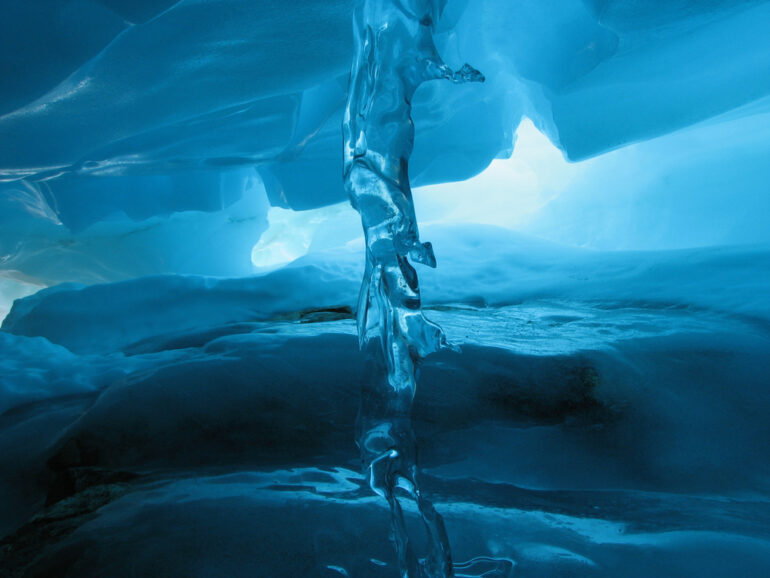Who knew frozen water could be so beautiful?
In the depths of winter, ice can get a bad rap—even in Canada. While no one likes black ice or the kind that you slip on when (hopefully) nobody’s watching, that clear frozen liquid produces some of the most interesting natural phenomena in the world.
Between giant balls of ice appearing on the shores of Lake Michigan and gorgeous, intricate shards scattering flower-like figures across a lake in British Columbia, it’s clear that even the fluffiest snow and powder-topped mountains can’t compete with the most beautiful state of frozen water—ice.
Ice circles
 Photo by Nagaev/Shutterstock
Photo by Nagaev/Shutterstock
Last year, a video that showed a frozen”‘spinning disk” in North Dakota’s Sheyenne River gained more than one million views in less than a week. The phenomena—which is shown in the video as etched, perfectly formed circles that rotate in the middle of a frozen body of water—is “an amazing wonder” according to a man overheard in the video—even scientists didn’t know what caused the spinning discs until a few years ago.
According to scientists, the phenomena is caused when a rapid temperature decrease and eddy current (water flowing in a circular motion) come into contact. Newly frozen chunks of ice on the outer edge of a body of water are pulled in by the rotational force, which are subsequently smoothed into perfect circles as they move through other formed pieces of ice.
More accurately named “ice circles,” the phenomena has been spotted mostly in Russia and North America and, as close by as Mississauga, Ontario, in 2008.
Ice balls
 Photo by Karel Bock/Shutterstock
Photo by Karel Bock/Shutterstock
Last February, hundreds of giant ice boulders were found piled along the shores of Lake Michigan. The entire shoreline near Traverse City, Michigan, was filled with the huge balls of ice, which had washed up on shore overnight.
A meteorologist from the area explained that the natural phenomena is comparable to rolling a giant snowball. For ice balls to form, the surface temperature of the water generally has to be much colder than the water itself. One tiny piece of ice forms, gets thrown back and forth through the waves all night and slowly grows, gathering additional layers of water and ice before being pushed to the shore. Ice balls are known to appear regularly on water surfaces throughout winter, though the size of the ones found during last year’s Polar Vortex are very rare.
Frost flowers
 Photo by Satoubin/Shutterstock
Photo by Satoubin/Shutterstock
Seemingly straight from Disney’s hit film Frozen—which fabulously showcases the natural beauty of winter and reminds us all why it should be our favourite season—frost flowers are one of the most delicate and intricate-looking natural ice formations.
These “flowers” aren’t actually clinging to any type of vegetation and are formed from an array of crystalline frost spikes that appear when warm water vapour emerges from thin surfaces of ice and hits cold air.
To form, frost flowers usually need calm, relatively windless conditions and a temperature difference of 15 degrees Celsius between the atmosphere and the ice surface. These specific conditions mean that frost flowers are typically found in polar regions (though they were spotted last year near Salmon Arm, B.C.) and usually only occur within the first few days of ice coverage.
Brinicles
 Photo Vladimir Nosikov/Shutterstock
Photo Vladimir Nosikov/Shutterstock
Brinicles are underwater icicles that form when regular sea water freezes around extremely briny water from the frozen surface. (Get it? Briny plus icicles).
As saltwater surfaces freeze, the saltier, and therefore denser water sinks and falls swiftly to the bottom in a downward plume. The freshwater around the descending briny mixture is so cold from being on the surface that it freezes around the briny water as it falls, creating a giant icicle under the surface.
Though extremely cool to see and captured on video for the first time by the BBC, the natural phenomena poses a risk to sea creatures who usually thrive beneath the water’s frozen surface.
The BBC time-lapse video eventually left the Antarctic brinicle with the nickname “icicle of death,” because it showed that the downward freezing motion does not stop, and instead continues to freeze parts of the ocean floor once contact is made.
Striped icebergs
 Photo by Tim Baffi/Shutterstock
Photo by Tim Baffi/Shutterstock
Icebergs are generally thought of as giant white blocks of ice that float along the surface of the water. Icebergs that form in the Arctic and Antarctic, however, have been seen to feature an array of colours including green, blue, black, and brown, and often look more like icebergs painted in Group of Seven hues than those that we’ve seen in classic films.
Blue stripes are formed from pure frozen water, which is how icebergs would naturally appear if air bubbles didn’t usually freeze in them and give a white hue from the reflection of light. Water that is rich in algae may freeze in a bright green, and glaciers that have tracked sediment may appear with lines of yellow, brown, or even black.
Related Story Is each snowflake really unique? The amazing science of snow
Related Story Keep an eye out for pancake ice (yum?)